Is Vilnius worth visiting? YES!
I recently spent a few days in Vilnius, and it’s fast become one of my new favourite cities.
Brimming with attractions, Lithuania’s capital is friendly and welcoming.
In fact, I think the Baltics are the most underrated area of Europe – here’s why!
Is Vilnius worth visiting? YES – here’s 10 reasons why!
Here are ten reasons to visit Vilnius in 2024!
UNESCO World Heritage Old City
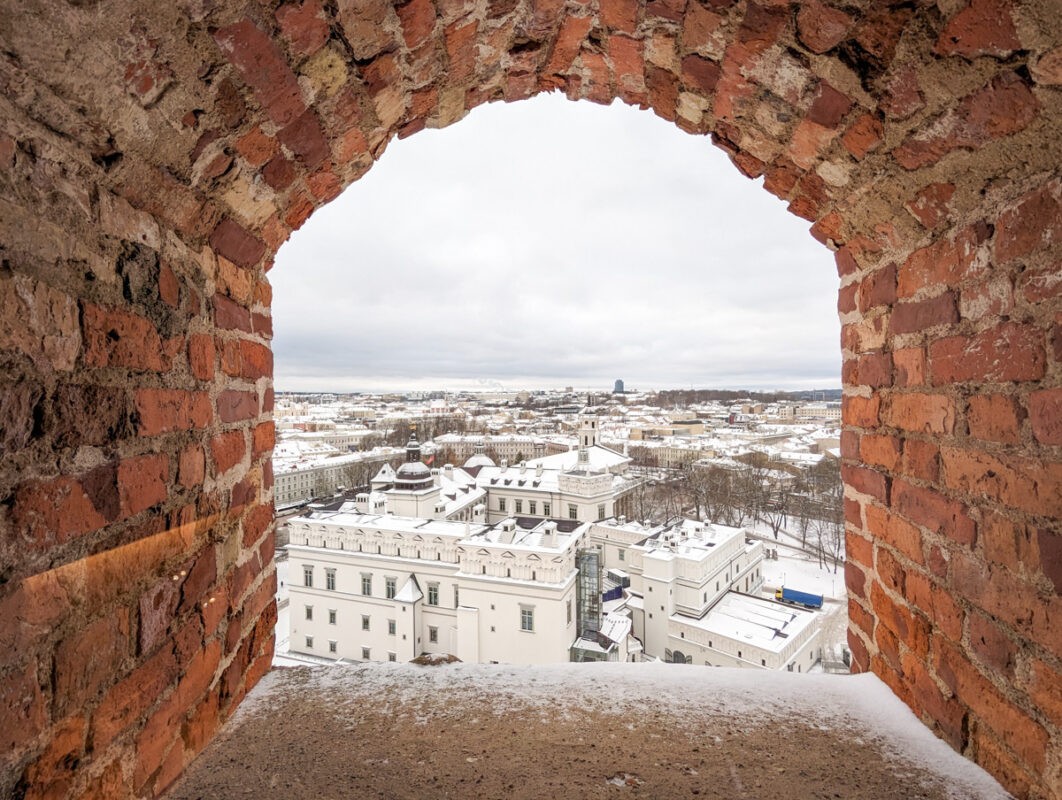
In the heart of Vilnius, you’ll find its UNESCO World Heritage Old Town, one of the most glorious old towns in all of Europe.
The narrow cobblestone streets weave past over 500 historic buildings, with Gothic, Renaissance and Baroque buildings beckoning.
The Old Town’s layout remains largely unchanged since its medieval days, with Landmarks like the Vilnius Cathedral and the University of Vilnius standing as grand reminders of the city’s past.
While the city’s like walking through a history book, the Old Town is alive with modern culture, with a variety of cafes, galleries and shops. When I visited, it was bedecked for Christmas too!
Other History
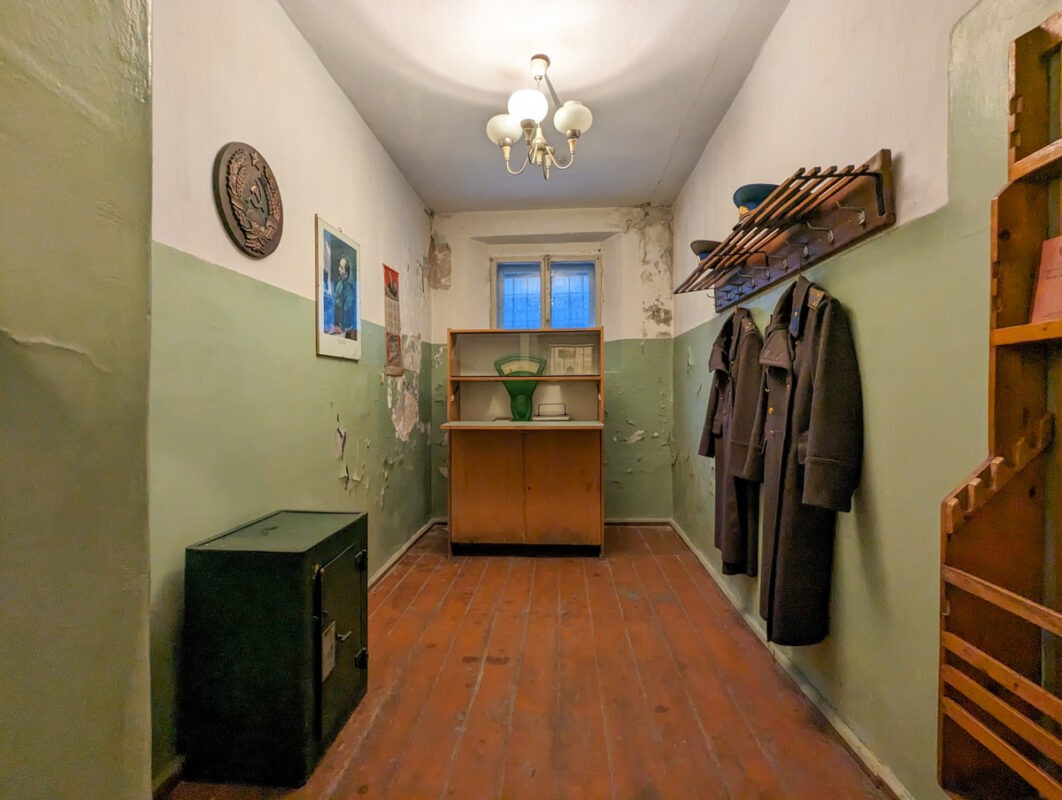
Lithuania’s history is long-spanning and fascinating.
While you can learn stories from its Medieval past in the Old City, there are also plenty of stories throughout the city, with an abundance of attractions telling the tale of the city.
Lithuania has strong Pagan connections; my guide told me it was the last remaining Pagan state in Europe. You can learn about this at Gediminas’ Tower, which has gorgeous panoramic views of the city.
While Lithuania is nowadays a small country, the Lithuanian-Polish Commonwealth was once one of the biggest in Europe, with territories spanning down to Ukraine. You can learn about this history at the National Museum of Lithuania.
At Vilnius Cathedral you can learn about the country and Catholicism (its main religion), and in the University Library, you can discover Lithuanian culture and literature.
Then there’s the tragic, but important to learn about, WW2 and Soviet-era history. Like all of the Baltics, Lithuania was invaded by the Soviets in 1940, then taken over by the Nazis, then overtaken again by the USSR.
It was a horrific time of deportations and locals turning against their own people, and I believe that this part of history is crucial to learn about so the same mistakes aren’t made in the future.
You can do so at the excellent Museum of Occupation and Freedom Fights which is situated in the old KGB offices. I also visited the small but informative Jewish Museum.
Art and culture

Vilnius effortlessly blends old and new to create a thriving and dynamic arts and culture scene – in fact, it was the European Capital of Culture in 2009.
The arts scene is perhaps centred around the quirky Užupis, a Vilnius neighbourhood that once used to be run down and dangerous, but was revived by students into an arty district. It gets quirkier – they ultimately declared it an independent republic!
Of course, Užupis is still legally a part of Vilnius and Lithuania, but it has its own constitution, government and even a border control office where you can have your passport stamped.
If you’re more into your books, head to Literatai Street, a celebration of Lithuanian writers.
The Lithuanian language is one of the oldest in the world, although literature in the language was banned during Soviet times.
While most Lithuanian people speak fluent English (largely due to its increasing presence on the tech world stage and not many films and movies being in Lithuanian!) and those who don’t usually speak Russian, locals are very proud of their language and are keen to protect it wherever possible.
This street is an example of this. It’s dotted with plaques celebrating local writers, along with some international novelists. “If you ever write a book, mention Lithuania and you’ll get a plaque here!” our guide told us.
One plaque is simply a set of teeth!
Events like the Vilnius Festival, Kino Pavasaris (Vilnius International Film Festival), and the Vilnius Book Fair attract participants and audiences from across the globe.
The performing arts scene in Vilnius is equally dynamic, with venues like the Lithuanian National Opera and Ballet Theatre being popular with locals and tourists alike.
Green spaces
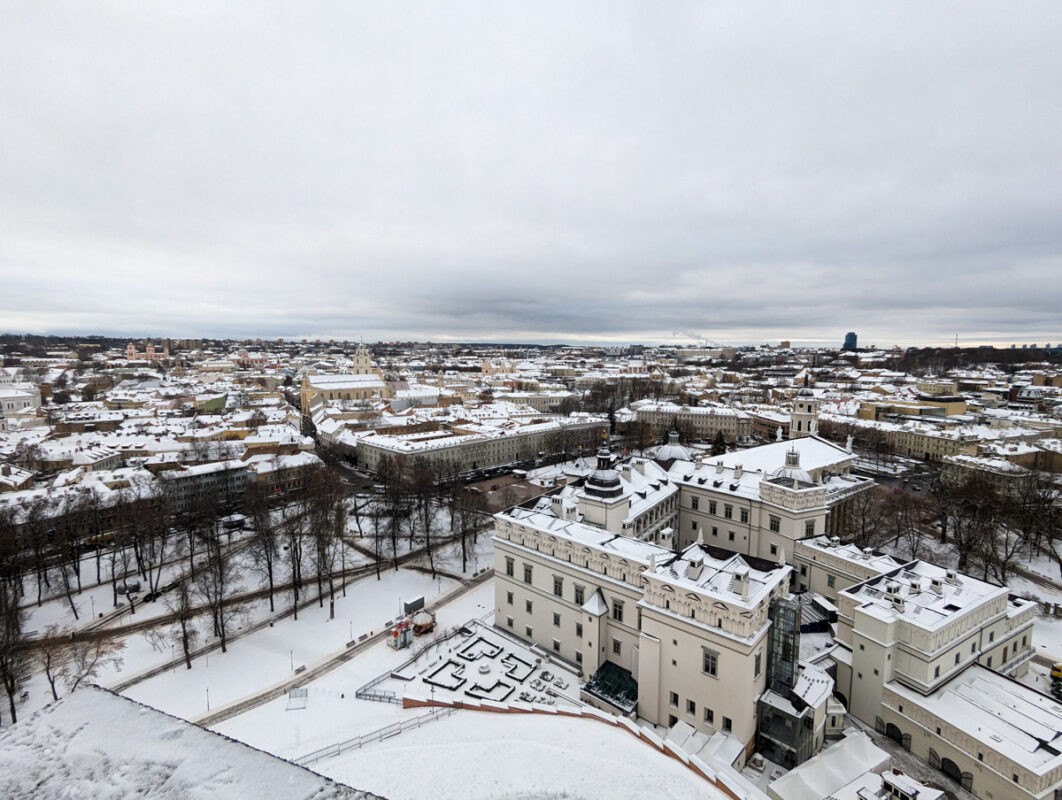
Vilnius is one of the greenest capitals in Europe; if you like nature within a city, it’s definitely worth visiting on these grounds!
At the heart of the city’s greenery is Vingis Park, the largest and most popular park in Vilnius.
Spanning over 160 hectares, it boasts expansive lawns, serene pathways, and the meandering Vilnia River.
Bernardine Garden, situated near the Old Town, is a beautifully landscaped park that blends natural beauty with historical charm, featuring a range of botanical attractions, a fountain, and a children’s playground.
Interested in botany? The Vilnius University Botanical Garden in Kairėnai is a must-visit. Home to over 10,000 plant species, the garden is not only a centre for scientific research but also a beautiful exhibition of flora from around the world.
Lazdynai Park and Žalieji Ežerai (Green Lakes) are other notable green spaces in the city. Lazdynai Park is known for its rolling hills and scenic views, while the Green Lakes area is a popular summer destination for swimming and sunbathing.
Ease of travel
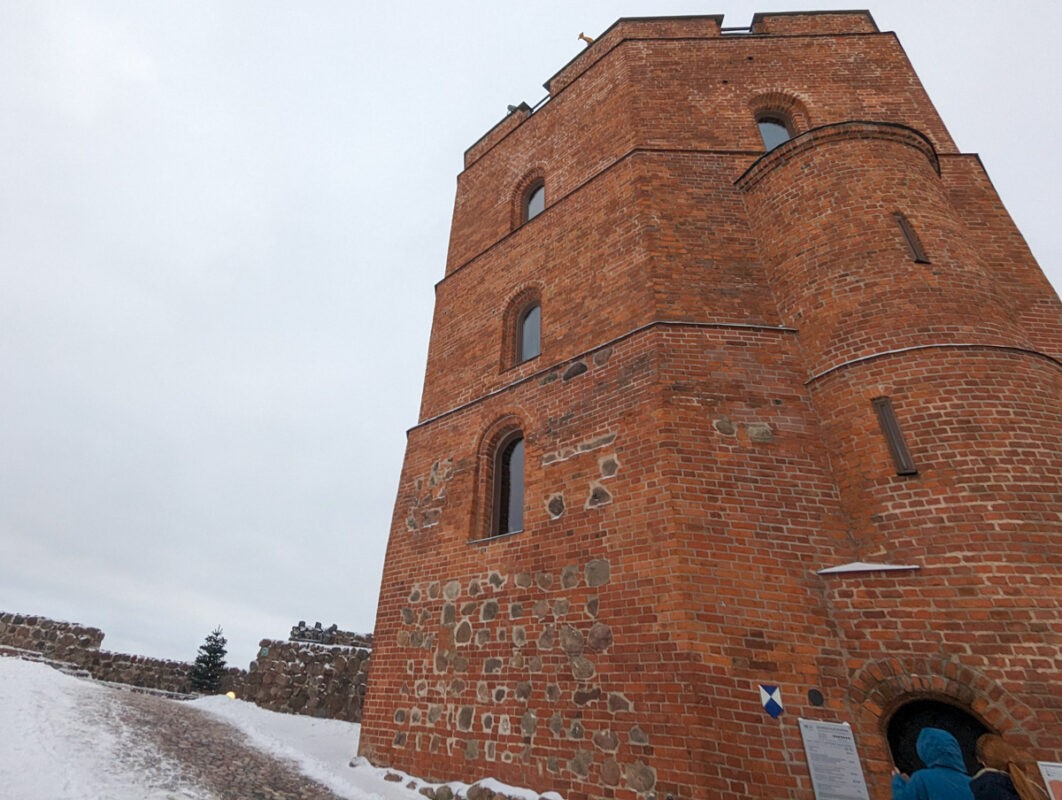
Vilnius (and all of the Baltics, to be honest) is one of the easiest places to travel around in Europe.
The overwhelming majority of locals speak excellent English – which, while it should never be expected, does make travel a little easier as a lingua franca.
I only had one interaction in my whole time there where I had difficulty making myself understood (I actually ended up using my poor Russian skills to communicate, as many of the older generations speak the language).
Lithuania is also a very tech-savvy place. While not as famous for start-ups as Estonia, plenty of European tech companies are setting up shop in the Western Baltic country (one of the most famous is Vinted, a Lithuanian company which is where I buy virtually all of my clothes these days!).
I didn’t need to use cash once while I was there – Google Pay was accepted everywhere (even my walking tour guide had a card reader!). The Bolt taxi app makes it effortless to get around and internet speeds are excellent.
I didn’t use public travel while I was in Vilnius, but from research, it seems like the buses run well.
Lithuania’s still a pretty affordable destination too – prices in Vilnius have risen in recent years, but they’re still cheaper than many other European capitals.
Safety

Another plus for visiting Vilnius is that it’s a very safe travel destination.
There are some outdated perceptions of the Baltics as somewhere that’s either a) under the influence of Russia or b) a wild, lawless place. Both interpretations are entirely untrue.
Lithuania was the first country to leave the USSR in 1990 and has been an independent country ever since. While it borders Belarus and has a significant Russian and Belarussian population, the countries have no impact on how Lithuania is run today.
Due to Lithuania’s membership in NATO and the EU, there’s very little chance that there could be an invasion like the devastating war in Ukraine. (If there was, it would have catastrophic consequences for the entirety of Europe and the USA).
After Lithuania became independent, it was a bit of a wild place for a while – but we’re talking 30+ years ago. From the turn of the century onwards, it’s been rapidly modernising, becoming a tech-savvy, forward-thinking nation.
The only note I will add is that, unfortunately, there is still some discrimination towards LGBTQ+ people.
Gay marriage is not yet legal and, while there are anti-discrimination laws, I have heard of a few instances where LGBTQ+ people have been made to feel uncomfortable.
This seems to be more of an issue in the Lithuanian countryside than its cities, but it’s worth taking into account if you are a part of the LGBTQ+ community.
Winter paradise

I loved visiting Vilnius in the winter months.
Snow’s not guaranteed, but there’s a good chance of seeing it – temperatures hovered around -5°C when I was there. (If you really want snow in the Baltics, however, Tallinn is your best bet).
In December, the days are short and dark, but the streets are glowing with festive lights and decorations.
There’s plenty of seasonal things to do, including ice skating and an ice sculpture park, and if you visit during the festive period there’s also the Vilnius Christmas Market.
This wasn’t my favourite market in the Baltics – Riga’s was better (although I preferred Vilnius as a city) – but there’s still festive cheer aplenty, great gluwein and a huge Christmas tree!
Ski 10 minutes from the city centre!

Another winter activity (that’s so unique it deserves its own section) is skiing – virtually in Vilnius!
The Liepkalnis Ski Resort is a selection of hills looking over Vilnius.
It’s not the Alps – the skiing is good for beginners, improvers or rusty skiers looking to refresh their skills, but if you go on an annual ski holiday in the mountains in Europe you may be a bit underwhelmed.
However, it’s surely one of the most accessible ski resorts on the continent – I hopped in a Bolt taxi and, 10 minutes and 3 euro later, I was at the resort!
You can book lift passes, ski rental and lessons, if required, online. I paid 33 euro for two hours of ski rental and lift passes.
Summer festivals
I was in Vilnius researching for my website Europe in winter, but a relatively common phrase I heard was “you should come back in summer for our festivals!”.
I loved the charm and solitude of the winter months, but many locals told me that the city positively buzzes in the summer.
Festivals include “Street Music Day” in May, “Vilnius Pink Soup Fest” which is dedicated to the nation’s favourite cold beetroot soup, and the “As Young As Vilnius” Festival which commemorates its Patron Saint, St. Christopher.
Joninės/Rasos commemorates Saint John’s Eve on the longest day of the year. It’s a Pagan festival (Lithuania was allegedly the last Pagan state and to this day many Pagan traditions and mindsets still prevail) with traditions like bonfires and wreath making.
Plus, there are plenty of music festivals throughout the season – take a look at Go Vilnius’s list here.
All that said, one of the festivals I’m personally most interested in is the Užgavėnes Festival, which marks the end of winter; in fact, the idea of the festival is to banish Winter and welcome Spring”. Definitely one I’m looking forward to covering on Europe in winter!
Food

Lithuanian food is hearty and warming – perfect for a winter trip – and there are plenty of restaurants in Vilnius to try it out.
I enjoyed the dumplings at Etno Dvaras, and was also recommended to visit Gabi Restaurant – although it seemed like a bit of a formal restaurant to what I was after.
Food-wise, popular items include “Cepelinai” which are potato dumplings filled with meat, curd or mushrooms and coated in sour cream and bacon sauce (but unfortunatley I was unable to find a veggie version!).
There’s also “Šaltibarščiai”, the famous beetroot soup – so popular there’s a whole festival about it!
Sweets-wise, “Šakotis” is one of the most popular desserts – although it’s most popular during festivals or celebrations.
Craft Beer
Vilnius is gaining acclaim for its dynamic craft beer scene.
This burgeoning sector is a haven for beer enthusiasts, characterized by an array of local breweries and microbreweries that blend traditional brewing methods with modern innovation to create distinctive and flavorful beers.
Want to enjoy Vilnius’s craft beer revolution? Check out the following bars:
- Šnekutis: A traditional Lithuanian pub known for its extensive selection of local beers. Šnekutis is celebrated for preserving old Lithuanian beer traditions, serving unique brews that reflect the country’s rich brewing heritage.
- Vilniaus Alus: This microbrewery is a testament to the artisanal beer movement in Vilnius. They specialize in crafting beers using historical Lithuanian recipes and methods, offering a genuine taste of local brewing history.
- Bambalynė: Placed in the Old Town, Bambalynė is both a bar and a shop specializing in Lithuanian craft beers. Here, you can explore a vast selection of beers from various small-scale Lithuanian breweries, each with its own story and flavour profile.
- Alaus Biblioteka (The Beer Library): As the name suggests, this place is a comprehensive repository of beers, featuring an impressive collection from around the world, including numerous Lithuanian craft beers. It’s a perfect spot for those looking to expand their beer knowledge and palate.
- Craft & Draft: A modern craft beer bar that offers a rotating selection of beers on tap. Craft & Draft is known for featuring both local and international craft beers, providing a broad perspective on the global craft beer scene.
- Dundulis: A prominent name in the Lithuanian craft beer scene, Dundulis brews with a focus on creativity and experimentation. They are known for their innovative use of ingredients and styles, often drawing inspiration from Lithuanian folklore and traditions.
Proximity to the rest of Lithuania (for day trips!)
You could spend weeks seeing Vilnius’s best attractions, but once you’ve ticked them all off, there’s plenty more to see around the city!
Vilnius’s strategic location makes it an ideal starting point for exploring the diverse attractions Lithuania has to offer.
Here’s a list of some notable day trip options from Vilnius:
- Trakai Historical National Park and Trakai Castle: Just a short drive from Vilnius, Trakai is famous for its picturesque island castle on Lake Galvė, rich history, and the Karaite community.
- Kaunas: Lithuania’s second-largest city, known for its vibrant cultural scene, historical architecture, and the Ninth Fort museum.
- Kernavė: A UNESCO World Heritage site, often referred to as Lithuania’s “Troy.” It’s an archaeological treasure with fascinating medieval history.
- Aukštaitija National Park: Ideal for nature lovers, this park offers lush forests, over 100 lakes, and numerous hiking trails, perfect for outdoor activities.
- Druskininkai: A spa town renowned for its mineral springs, offering relaxation, wellness treatments, and the Grūtas Park sculpture garden.
- The Hill of Crosses: A powerful cultural and religious symbol near Šiauliai, featuring thousands of crosses left by pilgrims and visitors.
- Anykščiai: Known for its scenic landscapes, the Treetop Walking Path, and the Narrow-Gauge Railway Museum, offering a blend of nature and culture.
- Rumsiskes Open-Air Museum: One of the largest open-air museums in Europe, showcasing traditional Lithuanian rural life through well-preserved buildings and artifacts.
- The Curonian Spit: A bit further away, but worth the trip for its unique landscape of sand dunes, beaches, and quaint fishing villages.
- Panevėžys: A city offering a blend of modern and historical attractions, including the Panevėžys Drama Theater and the Senvagė urban park.
Considerations for visiting Vilnius
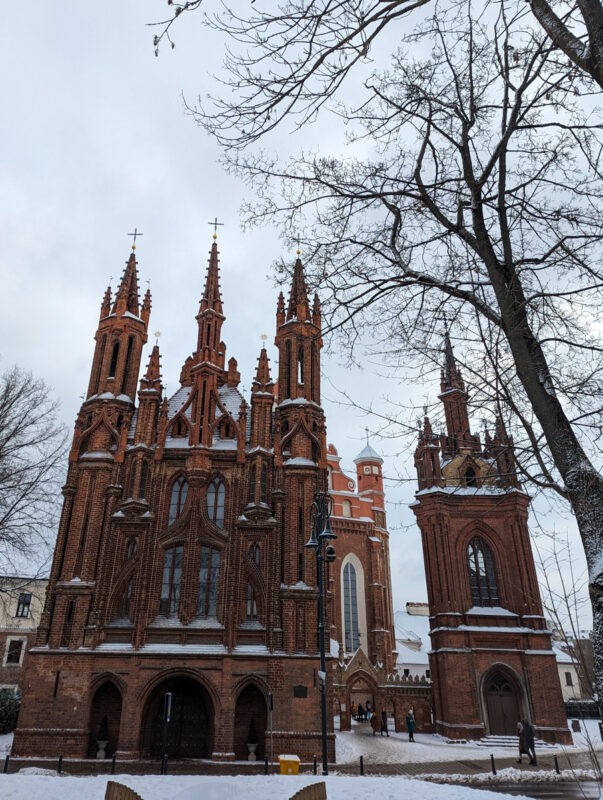
I always try to offer a balanced perspective when I write these “reasons to visit articles”. However, I can’t really think of any reasons not to visit Vilnius – there’s so much on offer here for all tastes!
Here are a few possible pointers:
- There aren’t many obvious family-orientated attractions, so it might not be the best break with younger kids. However, older kids should enjoy the culture and atmosphere!
- Being the Baltics, the weather’s not always great. In the winter, expect the cold, and in the summer months, the weather’s typically wet and unpredictable.
- There aren’t any nearby beaches (but there’s plenty of other nature). But, if you want to see the Baltic coast, Riga and Tallinn are much closer to/ on the coast.
- It’s a lot more affordable than other European cities, but prices have gone up in recent years.
Who should visit Vilnius

Here’s a list of people who I think would love a trip to Vilnius:
- History fans
- Art lovers
- Beginner or intermediate skiers
- Christmas market hoppers
- Budget travellers
- Adventurous couples
So, is Vilnius worth visiting?
I’m sure you can guess by now, but I absolutely adored Vilnius and would implore anyone to book a trip here!
If you want to learn more about my trip there, check out my YouTube video.
